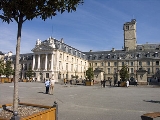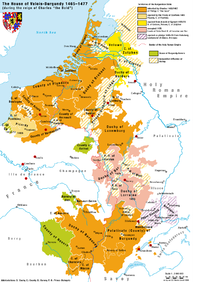
Palace of the Dukes of Burgundy
Encyclopedia
The Palace of the Dukes and Estates of Burgundy or palais des ducs et des États de Bourgogne is a remarkably well-preserved architectural assemblage in Dijon
. The oldest part is the 14th and 15th century Gothic
ducal palace and seat of the Dukes of Burgundy, made up of a logis still visible on place de la Liberation, the ducal kitchens on cour de Bar, the tour de Philippe le Bon, a "guette" overlooking the whole city, and tour de Bar. Most of what can be seen today, however, was built in the 17th and especially the 18th centuries, in a classical style, when the palace was a royal residence building and housed the estates of Burgundy
. Finally, the 19th façade of the musée
on place de la Sainte-Chapelle was added on the site of the palace's Sainte-Chapelle, demolished in 1802. The Palace houses the city's town hall and the musée des Beaux-Arts
.
 The Duchy of Burgundy
The Duchy of Burgundy
was founded in the 9th century around the year 880 from the Kingdom of Burgundy
, by the Carolingian kings Louis III
and Carloman II of France, and the princes who shared the Carolingian Empire
after reorganizing the entire kingdom into duchies and counties.
Richard II of Burgundy, known as Richard the Avenger, was named marquis
and first Duke of Burgundy. He was one of the six Peerage of France
installed under his suzerain, King Louis III of France.
was occupied by the Kingdom of France
after the death of Charles the Bold, in 1477, and the treaty of Arras
of 1482 between the king Louis XI
and Maximilian I, Holy Roman Emperor
.
s to rule Burgundy. Sometimes they came personally to Dijon
, where the palace was turned into a royal residence to receive them while in the province of Burgundy.
Dijon
Dijon is a city in eastern France, the capital of the Côte-d'Or département and of the Burgundy region.Dijon is the historical capital of the region of Burgundy. Population : 151,576 within the city limits; 250,516 for the greater Dijon area....
. The oldest part is the 14th and 15th century Gothic
Gothic architecture
Gothic architecture is a style of architecture that flourished during the high and late medieval period. It evolved from Romanesque architecture and was succeeded by Renaissance architecture....
ducal palace and seat of the Dukes of Burgundy, made up of a logis still visible on place de la Liberation, the ducal kitchens on cour de Bar, the tour de Philippe le Bon, a "guette" overlooking the whole city, and tour de Bar. Most of what can be seen today, however, was built in the 17th and especially the 18th centuries, in a classical style, when the palace was a royal residence building and housed the estates of Burgundy
Estates of Burgundy
In Burgundy, under the Ancien Régime, impôts, aides and subsides as well as the provincial economic administration were, at least in theory, put under a general assembly which occurred every three years - the Estates of Burgundy...
. Finally, the 19th façade of the musée
Musée des Beaux-Arts de Dijon
The Musée des Beaux-Arts de Dijon is a museum of fine arts opened in 1787 in Dijon, France. It is housed in the Palace of the Dukes of Burgundy in the historic center of Dijon.- Artworks :The Musée include a large and varied collection of art:...
on place de la Sainte-Chapelle was added on the site of the palace's Sainte-Chapelle, demolished in 1802. The Palace houses the city's town hall and the musée des Beaux-Arts
Musée des Beaux-Arts de Dijon
The Musée des Beaux-Arts de Dijon is a museum of fine arts opened in 1787 in Dijon, France. It is housed in the Palace of the Dukes of Burgundy in the historic center of Dijon.- Artworks :The Musée include a large and varied collection of art:...
.
History of the Palace of the Dukes

Duchy of Burgundy
The Duchy of Burgundy , was heir to an ancient and prestigious reputation and a large division of the lands of the Second Kingdom of Burgundy and in its own right was one of the geographically larger ducal territories in the emergence of Early Modern Europe from Medieval Europe.Even in that...
was founded in the 9th century around the year 880 from the Kingdom of Burgundy
Kingdom of Burgundy
Burgundy is a historic region in Western Europe that has existed as a political entity in a number of forms with very different boundaries. Two of these entities - the first around the 6th century, the second around the 11th century - have been called the Kingdom of Burgundy; a third was very...
, by the Carolingian kings Louis III
Louis III of France
Louis III was the King of France, still then called West Francia, from 879 until his death. The second son of Louis the Stammerer and his first wife, Ansgarde, he succeeded his father to reign jointly with his younger brother Carloman II, who became sole ruler on Louis's death...
and Carloman II of France, and the princes who shared the Carolingian Empire
Carolingian Empire
Carolingian Empire is a historiographical term which has been used to refer to the realm of the Franks under the Carolingian dynasty in the Early Middle Ages. This dynasty is seen as the founders of France and Germany, and its beginning date is based on the crowning of Charlemagne, or Charles the...
after reorganizing the entire kingdom into duchies and counties.
Richard II of Burgundy, known as Richard the Avenger, was named marquis
Marquis
Marquis is a French and Scottish title of nobility. The English equivalent is Marquess, while in German, it is Markgraf.It may also refer to:Persons:...
and first Duke of Burgundy. He was one of the six Peerage of France
Peerage of France
The Peerage of France was a distinction within the French nobility which appeared in the Middle Ages. It was abolished in 1789 during the French Revolution, but it reappeared in 1814 at the time of the Bourbon Restoration which followed the fall of the First French Empire...
installed under his suzerain, King Louis III of France.
The Dukes of Burgundy ruler of the Duchy of Burgundy (1363-1477)
- Philip the BoldPhilip the BoldPhilip the Bold , also Philip II, Duke of Burgundy , was the fourth and youngest son of King John II of France and his wife, Bonne of Luxembourg. By his marriage to Margaret III, Countess of Flanders, he also became Count Philip II of Flanders, Count Philip IV of Artois and Count-Palatine Philip IV...
(1342-1404), son of the King John II of FranceJohn II of FranceJohn II , called John the Good , was the King of France from 1350 until his death. He was the second sovereign of the House of Valois and is perhaps best remembered as the king who was vanquished at the Battle of Poitiers and taken as a captive to England.The son of Philip VI and Joan the Lame,... - John the Fearless (1371-1419)
- Philip the Good (1396-1467)
- Charles the Bold (1433-1477)
Palace of the Estates of Burgundy
The palace turned into a Royal residence when the Duchy of BurgundyDuchy of Burgundy
The Duchy of Burgundy , was heir to an ancient and prestigious reputation and a large division of the lands of the Second Kingdom of Burgundy and in its own right was one of the geographically larger ducal territories in the emergence of Early Modern Europe from Medieval Europe.Even in that...
was occupied by the Kingdom of France
Kingdom of France
The Kingdom of France was one of the most powerful states to exist in Europe during the second millennium.It originated from the Western portion of the Frankish empire, and consolidated significant power and influence over the next thousand years. Louis XIV, also known as the Sun King, developed a...
after the death of Charles the Bold, in 1477, and the treaty of Arras
Treaty of Arras (1482)
The Treaty of Arras was signed at Arras on 23 December 1482 by King Louis XI of France and Archduke Maximilian I of Habsburg as heir of the Burgundian Netherlands in the course of the Burgundian succession crisis....
of 1482 between the king Louis XI
Louis XI of France
Louis XI , called the Prudent , was the King of France from 1461 to 1483. He was the son of Charles VII of France and Mary of Anjou, a member of the House of Valois....
and Maximilian I, Holy Roman Emperor
Maximilian I, Holy Roman Emperor
Maximilian I , the son of Frederick III, Holy Roman Emperor and Eleanor of Portugal, was King of the Romans from 1486 and Holy Roman Emperor from 1493 until his death, though he was never in fact crowned by the Pope, the journey to Rome always being too risky...
.
Governors of Burgundy
After 1477, the kings of France named governorGovernor
A governor is a governing official, usually the executive of a non-sovereign level of government, ranking under the head of state...
s to rule Burgundy. Sometimes they came personally to Dijon
Dijon
Dijon is a city in eastern France, the capital of the Côte-d'Or département and of the Burgundy region.Dijon is the historical capital of the region of Burgundy. Population : 151,576 within the city limits; 250,516 for the greater Dijon area....
, where the palace was turned into a royal residence to receive them while in the province of Burgundy.

